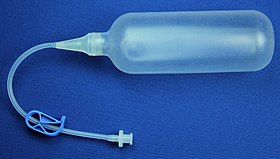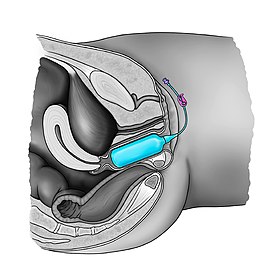Vaginal dilator
A vaginal dilator (sometimes called a vaginal trainer)[1] is an instrument used to gently stretch the vagina. They are used when the vagina has become narrowed (vaginal stenosis), such as after brachytherapy for gynecologic cancers,[2] and as therapy for vaginismus and other forms of dyspareunia.[3]

There is mixed evidence for their use, and studies have reported psychological damage from dilator treatment. Rectovaginal fistulae have also been linked to dilator use.[2]
Vaginal dilators, also called vaginal stents or vaginal expanders, can be inflatable and are used during surgeries.[4][5] Vaginal stents are routinely used in postoperative care for patients who have undergone male-to-female sex reassignment surgery and for other conditions, such as vaginal agenesis.[6] The vaginal expander is used immediately after surgery to keep the passage from healing, and regularly thereafter to maintain the viability of the neovagina. Frequency of use requirements decrease over time, but remains obligatory lifelong.[7][8]
Use
With solid vaginal dilators, the patient starts with the smallest dilator size, then gradually increasing until the largest dilator size is reached. This practice can be accompanied by breathing exercises in order to relax the pelvic floor muscles. Dilation acts should not cause pain or bleeding.[9] Dilatation with rigid dilators must be done carefully as vaginal perforation and urethral injury may occur.[10][11] There is no consensus on the frequency and duration of using vaginal dilators.[12] In case of vaginal expanders, the therapist or the patient introduces the deflated balloon into the vagina and then inflates it gently until the required diameter is obtained.[6]
Image gallery


References
- "Vaginismus". National Health Service. Retrieved 2020-02-29.
- Miles, Tracie; Johnson, Neal (2014). "Vaginal dilator therapy for women receiving pelvic radiotherapy". Cochrane Database Syst Rev. 9 (9): CD007291. doi:10.1002/14651858.CD007291.pub3. PMC 6513398. PMID 25198150.
- Idama, T. O.; Pring, D. W. (2000). "Vaginal dilator therapy-an outpatient gynaecological option in the management of dyspareunia". Journal of Obstetrics and Gynaecology. 20 (3): 303–05. doi:10.1080/01443610050009683. PMID 15512559.
- Coskun, Ayhan; Coban, Yusuf Kenan; Vardar, Mehmet Ali; Dalay, Ahmet Cemil (10 July 2007). "The use of a silicone-coated acrylic vaginal stent in McIndoe vaginoplasty and review of the literature concerning silicone-based vaginal stents: a case report". BMC Surgery. 7 (1). doi:10.1186/1471-2482-7-13.
- Barutçu, Ali; Akgüner, Muharrem (November 1998). "McIndoe Vaginoplasty with the Inflatable Vaginal Stent". Annals of Plastic Surgery. 41 (5): 568. doi:10.1097/00000637-199811000-00020.
- Antoniadis, N; Charles, G; Mejías, I; Pabón, R. "Vaginoplasty: modification to McIndoe techique using hemostatic gel sponge". Cirugía Plástica Ibero-Latinoamericana. 37 (1): 73–77.
- Rinzler, Carol Ann (12 May 2010). The Encyclopedia of Cosmetic and Plastic Surgery. Facts on File library of health and living. New York: Infobase Publishing. p. 195. ISBN 978-1-4381-2702-6. OCLC 223107099. Retrieved 31 May 2018.
- Georgiade, Gregory S.; Georgiade, Nicholas G. (1992). Textbook of plastic, maxillofacial, and reconstructive surgery. Baltimore, Maryland: Williams & Wilkins. ISBN 978-0-683-03454-7. OCLC 455225627. Retrieved 31 May 2018.
- Psychosexual Team, Oxfordshire Sexual Health Service. "Vaginal Dilator Exercises for Psychosexual Therapy" (PDF). Oxford University Hospitals NHS Foundation Trust.
- HOFFMAN, M (May 2003). "Risks of rigid dilation for a radiated vaginal cuff: two related rectovaginal fistulas". Obstetrics & Gynecology. 101 (5): 1125–1126. doi:10.1016/s0029-7844(02)02624-8.
- Lue, Kathy; Heinsimer, Kevin; Madiraju, SriGita K.; Rideout, Drew; Wiegand, Lucas (January 2020). "Urologic trauma from vaginal dilation for congenital vaginal stenosis: A newly-described and challenging complication". Urology Case Reports. 28: 101075. doi:10.1016/j.eucr.2019.101075.
- Liu, Marisa; Juravic, Mark; Mazza, Genevieve; Krychman, Michael L. (January 2020). "Vaginal Dilators: Issues and Answers". Sexual Medicine Reviews. doi:10.1016/j.sxmr.2019.11.005.